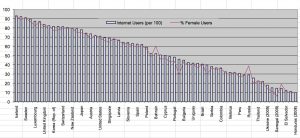In most countries of the world, women and girls have lower levels of access and ownership of information and communications technologies (ICTs) than men:

The effects on women of technology are not adequately understood or taken into account:
- Seatbelts are dangerous for pregnant women and their fetus;
- Airbags are designed for the 180 lb male – causing risk of harm to children and small women
Women’s productive activities are not adequately supported by technology and resources:
Female farmers have 20-30% lower productivity than males – for example, the productivity of women farmers in Burkino Faso is 18% less than male members of the same household

Worldwide, businesses run by female entrepreneurs have lower levels of productivity than male-managed enterprises with lower levels of value added per worker:
34% less in Europe/Central Asia, 35% in Latin America and 6-8% in sub-Saharan Africa.
In Bangladesh, the average output per worker is eight times – 800% – higher in firms operated by men,
Inefficient, high-emission cookstoves and cooking facilities continue to affect the health of women and children globally. Approx 2.7 billion people worldwide rely on open fires and traditional stoves for cooking and heating.

The number of people who die prematurely each year from the indoor use of biomass is just under 1.5 million – more than the total deaths from malaria and tuberculosis combined. Girls and women are predominantly responsible for the provision of firewood and for cooking family meals: rates of respiratory illness are the same for girls and boys until age 5, when boys leave the house for school and other activities. From that point, rates of illness consistently increase for girls and women, in the form of eye problems, cancer and asthma relating to cookstove emissions and indoor air pollution.
But we also know this can be changed:
- Equalizing access to productive resources for female farmers – fertilizers, extension, technology and credit – could increase agricultural output in developing countries by 2.5 – 4 % and result in 100 to 150 million fewer hungry people globally.
- If women’s paid employment rates were raised to the same level as men’s, GDP would rise 5% in the US, 9% in Japan, and 12% in the United Arab Emirates and a huge 34% in Egypt.
- Bringing more women into STI will bring the talent and ability of half of the population to bear on these challenges
- Having more females scientists, technologists and engineers will enable better relationships with women farmers, enterprise owners, health care workers and foresters.
Findings of the National Assessments on Gender and STI project:

- The numbers of women in the science, technology and innovation fields are alarmingly low in the world’s leading economies, and are actually on the decline in many, including the United States.
- Women remain severely under-represented in engineering, physics and computer science enrollments — less than 30% in most countries – while the numbers of women working in these fields are also declining.
- Women have lower levels of access to the productive resources necessary to support active engagement in STI – property (land); finance; technology; and education.
- The translation from women’s proportion of S&E enrolments to S&E workforce sees a drop of 30% in most of the countries in the study.
- Women continue to be underrepresented in fields such as energy, industry, construction and engineering. The share of female employees in the energy industry is estimated at only 20 percent, with most working in nontechnical areas.
